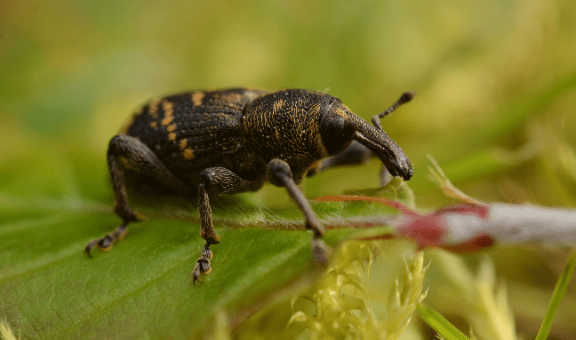A blog by Cat Kent, Assistant Forest Manager for Tilhill in South West Scotland. #PlantHealthWeek
Standing on a conifer restock site between March and November you are pretty much guaranteed to see Hylobius abietis (Hylobius) at some point. The presence of Hylobius, or the large pine weevil as it is commonly known, on first inspection may seem insignificant, but many a forester will know of the significant damage these critters, who are a little over 1cm in length, can do in a very short time frame.
In fact Hylobius is regarded as one of the biggest threats to newly planted trees on restock sites, with conservative estimates suggesting that the direct cost of Hylobius damage to forest owners in the UK is in the region of £5 million/annum.
Conifer restocks are attractive to Hylobius because they support all stages of their lifecycle. When conifers are felled they release volatiles which attract adults to migrate to the site. They lay eggs in the left over stumps, which provide an area for the larvae to mature to adulthood. In late summer a new generation of adults emerge and begin to feed on the phloem, cambium and bark of newly planted saplings. If all the bark around the stem is stripped, known as girdling, the tree will die.
When Hylobius populations are high they can wipe out entire restock crops. At lower populations or when trees are moderately damaged there is still an impact to the tree’s quality and form, which can have a negative economic impact when they are being harvested. Thus, it is important to effectively control Hylobius populations and limit the level of damage they cause. This can be done through a number of ways:
- Fallow Period:
Leaving a site fallow for between two and four years before replanting can reduce its ability to support large populations and force adult Hylobius to disperse to alternative and more suitable breeding sites. However, it can also result in substantial weed growth which requires the application of herbicides to control it and lengthens the rotation time, so is not always considered a suitable Hylobius control strategy.
- Integrated Pest Management:
Integrated pest management focusses on using non-chemical control options, or combining them with chemical controls, rather than relying solely on chemicals as a first response to pest issues. This can include planting robust, stronger trees that are better able to withstand Hylobius attack or utilising decision support tools like Forest Research’s Hylobius Management Support System (HMSS) which uses population dynamics, amongst other data, to predict the likelihood of damage and recommend treatment options.
- Biological Controls:
The number of adult Hylobius emerging from stumps can be significantly reduced, and subsequently the level of damage to nearby saplings and the amount of adults migrating to new sites, by applying entomopathogenic nematodes (Steinernema carpocapsae) to stumps where larvae are growing . However the application process requires high volumes of water and specialised equipment, making the use of nematodes only practical and cost efficient in more accessible areas.
- Physical Barriers:
Physical barriers including tree shelters, waxed paper sleeves and various polymer and wax coatings sprayed directly onto the trees have been trialled. Some have been successfully used in Scandinavia, but trials in the UK, where Hylobius populations are significantly higher, have found them to be useful only if on-site populations are low.
- Insecticides:
Even when a combination of non-chemical controls are used it is often not possible to avoid Hylobius damage and sometimes the only option remaining is to use an insecticide. Currently, the main insecticide used is acetamiprid and it is applied to the trees pre-planting at the nursery or post-planting, when weevil populations are high.
Although used as a last resort it is quite likely that in the future the use of acetamiprid may become more restricted. If there are no effective alternative Hylobius control options in place it may become economically unviable to restock some areas after harvesting – crop quality will be adversely affected and future timber availability will be reduced. Thus, it is important to find a suitable alternative, and ideally one which does not rely on insecticides.
Over the last eleven years Tilhill, in partnership with Maelor Forest Nurseries Ltd, Cumbria University and Scottish Woodlands and, historically, with the Forestry Commission and Forest Research, has been involved in trials to find such an alternative.
The trials so far have looked at 150 combinations of different products including physical and biological controls and different application methods and rates of chemicals. The more recent trials have placed more focus on biological controls, repellents and physical coatings and barriers, including Neem extracts, waxed paper sleeves and various polymer and wax coatings sprayed directly onto the trees.
Through my role as an Assistant Forest Manager I have had the chance to get involved in some of these trials and I am keen to see if any of the 9 treatments we are trialling this year will provide the solution.
This blog was published during #PlantHealthWeek as part of the International Year of Plant Health.
Cat Kent BSc (Hons) Countryside Management, Assistant Manager.
Cat graduated from Harper Adams University and joined the team through the Tilhill Graduate Programme. She became interested in pursuing a career in forestry after undertaking placement years with the National Trust as a volunteer ranger at Cragside in Northumberland and as a student arborist at Westonbirt, the National Arboretum, in Gloucestershire.




